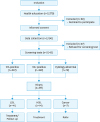1. Ferlay J, Soerjomataram I, Ervik M, Dikshit R, Eser S, Mathers C, et al. GLOBOCAN 2012: estimated cancer incidence, mortality and prevalence worldwide in 2012. GLOBOCAN 2012 v1.0 [Internet]. Lyon: International Agency for Research on Cancer;2013. cited 2016 Jan 10. Available from:
http://globocan.iarc.fr/Pages/fact_sheets_cancer.aspx.
2. Sankaranarayanan R, Budukh AM, Rajkumar R. Effective screening programmes for cervical cancer in low- and middle-income developing countries. Bull World Health Organ. 2001; 79:954–962.
3. Hakama M. Screening for cervical cancer. In : Miller AB, editor. Epidemiologic studies in cancer prevention and screening. New York, NY: Springer;2013. p. 223–232.
4. Raychaudhuri S, Mandal S. Current status of knowledge, attitude and practice (KAP) and screening for cervical cancer in countries at different levels of development. Asian Pac J Cancer Prev. 2012; 13:4221–4227.

5. ICO/IARC Information Centre on HPV and Cancer. Nepal: human papillomavirus and related cancers, fact sheet 2016. Barcelona: ICO/IARC Information Centre on HPV and Cancer;2016.
6. Jha AK, Jha J, Bista R, Basnet B, Kandel P, Lama G, et al. A scenario of cervical carcinoma in a cancer hospital. JNMA J Nepal Med Assoc. 2009; 48:199–202.

7. Shakya S, Syversen U, Åsvold BO, Bofin AM, Aune G, Nordbø SA, et al. Prevalence of human papillomavirus infection among women in rural Nepal. Acta Obstet Gynecol Scand. 2017; 96:29–38.

8. Ranjit A, Gupta S, Shrestha R, Kushner AL, Nwomeh BC, Groen RS. Awareness and prevalence of cervical cancer screening among women in Nepal. Int J Gynaecol Obstet. 2016; 134:37–40.

9. Central Bureau of Statistics (NP). Nepal multiple indicator cluster survey 2010: mid- and far western regions. Kathmandu: Central Bureau of Statistics;2012.
10. Central Bureau of Statistics (NP). National population and housing census 2011: vol 1. Kathmandu: Central Bureau of Statistics;2012.
11. Sharma P, Guha-Khasnobis B, Raj Khanal D. Nepal human development report 2014. Kathmandu: National Planning Commission;2014.
13. District Health Office (NP). District Health Office report. Jumla: District Health Office;2011.
14. Family Health Division (NP). Cervical cancer screening & prevention (CCSP) in Nepal: a reference manual. Kathmandu: Ministry of Health and Population, Department of Health Services;2015.
15. Sankaranarayanan R, Wesley R. A practical manual on visual screening for cervical neoplasia: IARC technical report no. 41. Lyon: International Agency for Research on Cancer;2003.
16. Solomon D, Davey D, Kurman R, Moriarty A, O'Connor D, Prey M, et al. The 2001 Bethesda System: terminology for reporting results of cervical cytology. JAMA. 2002; 287:2114–2119.

17. Kurman RJ. International Agency for Research on Cancer. World Health Organization. WHO classification of tumours of female reproductive organs. 4th ed. Lyon: International Agency for Research on Cancer;2014.
18. Tamrakar SR, Chawla CD. A clinical audit of pap smear test for screening of cervical cancer. Nepal J Obstet Gynaecol. 2012; 7:21–24.

19. Marahatta Khanal R. Value of conventional cervical cytology as a screening test for cervical cancer. Nepal Med Coll J. 2014; 16:63–67.
20. Sherpa AT, Clifford GM, Vaccarella S, Shrestha S, Nygård M, Karki BS, et al. Human papillomavirus infection in women with and without cervical cancer in Nepal. Cancer Causes Control. 2010; 21:323–330.

21. Bhatta MP, Johnson DC, Lama M, Aryal S, Lhaki P, Shrestha S. High-risk human papillomavirus infection and abnormal cervical cytology among Nepali and Bhutanese refugee women living in eastern Nepal. BMC Infect Dis. 2017; 17:73.

22. Sørbye SW, Suhrke P, Revå BW, Berland J, Maurseth RJ, Al-Shibli K. Accuracy of cervical cytology: comparison of diagnoses of 100 Pap smears read by four pathologists at three hospitals in Norway. BMC Clin Pathol. 2017; 17:18.

23. Fokom-Domgue J, Combescure C, Fokom-Defo V, Tebeu PM, Vassilakos P, Kengne AP, et al. Performance of alternative strategies for primary cervical cancer screening in sub-Saharan Africa: systematic review and meta-analysis of diagnostic test accuracy studies. BMJ. 2015; 351:h3084.

24. Shastri SS, Dinshaw K, Amin G, Goswami S, Patil S, Chinoy R, et al. Concurrent evaluation of visual, cytological and HPV testing as screening methods for the early detection of cervical neoplasia in Mumbai, India. Bull World Health Organ. 2005; 83:186–194.
25. Adjorlolo-Johnson G, Unger ER, Boni-Ouattara E, Toure-Coulibaly K, Maurice C, Vernon SD, et al. Assessing the relationship between HIV infection and cervical cancer in Cote d’Ivoire: a case-control study. BMC Infect Dis. 2010; 10:242.

26. Muwonge R, Ngo Mbus L, Ngoma T, Gombe Mbalawa C, Dolo A, da Ganda Manuel M, et al. Socio-demographic and reproductive determinants of cervical neoplasia in seven sub-Sahara African countries. Cancer Causes Control. 2016; 27:1437–1446.

27. Louie KS, De Sanjose S, Diaz M, Castellsagué X, Herrero R, Meijer CJ, et al. Early age at first sexual intercourse and early pregnancy are risk factors for cervical cancer in developing countries. Br J Cancer. 2009; 100:1191–1197.










 PDF
PDF Citation
Citation Print
Print



 XML Download
XML Download